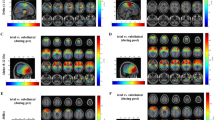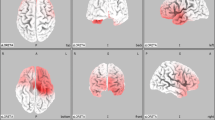Abstract
Valproate (VPA) is an antiepileptic drug (AED) used for initial monotherapy in treating childhood absence epilepsy (CAE). EEG might be an alternative approach to explore the effects of AEDs on the central nervous system. We performed a comparative analysis of background EEG activity during VPA treatment by using standardized, low-resolution, brain electromagnetic tomography (sLORETA) to explore the effect of VPA in patients with CAE. In 17 children with CAE, non-parametric statistical analyses using sLORETA were performed to compare the current density distribution of four frequency bands (delta, theta, alpha, and beta) between the untreated and treated condition. Maximum differences in current density were found in the left inferior frontal gyrus for the delta frequency band (log-F-ratio = −1.390, P > 0.05), the left medial frontal gyrus for the theta frequency band (log-F-ratio = −0.940, P > 0.05), the left inferior frontal gyrus for the alpha frequency band (log-F-ratio = −0.590, P > 0.05), and the left anterior cingulate for the beta frequency band (log-F-ratio = −1.318, P > 0.05). However, none of these differences were significant (threshold log-F-ratio = ±1.888, P < 0.01; threshold log-F-ratio = ±1.722, P < 0.05). Because EEG background is accepted as normal in CAE, VPA would not be expected to significantly change abnormal thalamocortical oscillations on a normal EEG background. Therefore, our results agree with currently accepted concepts but are not consistent with findings in some previous studies.


Similar content being viewed by others
References
Glauser T, Ben-Menachem E, Bourgeois B et al (2006) ILAE treatment guidelines: evidence-based analysis of antiepileptic drug efficacy and effectiveness as initial monotherapy for epileptic seizures and syndromes. Epilepsia 47:1094–1120
Glauser T, Cnaan A, Shinnar S et al (2010) Ethosuximide, valproic acid, and lamotrigine in childhood absence epilepsy. N Engl J Med 362:790–799
Panayiotopoulos CP (2001) Treatment of typical absence seizures and related syndromes. Pediatr Drugs 379–403
Snead OC (1995) Basic mechanisms of generalized absence seizures. Ann Neurol 37:146–157
Shahar E, Andraus J, Sagie-Lerman T et al (2002) Valproic acid therapy inducing absence status evolving into generalized seizures. Pediatr Neurol 26:402–404
Loscher W (1999) Valproate: a reappraisal of pharmacologic properties and mechanism of action. Prog Neurobiol 58:31–59
Macdonald RL, Kelly KM (1995) Antiepileptic drug mechanism of action. Epilepsia 36(Suppl 2):S2–S12
Clemens B, Puskás S, Besenyei M et al (2014) Valproate treatment normalizes EEG functional connectivity in successfully treated idiopathic generalized epilepsy patients. Epilepsy Res 108:1896–1903
Steriade M (2001) Impact of network activities on neuronal properties in corticothalamic systems. Am Physiol Soc 86:1–39
Clemens B (2008) Valproate decreases EEG synchronization in a use-dependent manner in idiopathic generalized epilepsy. Seizure 17:224–233
Khachidze I, Gugushvili M, Makashvili M et al (2015) The investigation of EEG specificity in epileptic children during Depakine therapy. Int J Neurosci. doi:10.3109/00207454.2015.1083991
Commission on Classification and Terminology of the International League Against Epilepsy (1989) Proposal for revised classification of epilepsies and epileptic syndromes. Commission on classification and terminology of the international League against epilepsy. Epilepsia 30:389–399
Clemens B, Bessenyei M, Tóth M et al (2007) Valproate selectively reduces EEG activity in anterior parts of the cortex in patients with idiopathic generalized epilepsy. A low resolution electromagnetic tomography (LORETA) study. Epilepsy Res 75:186–191
Clemens B, Piros P, Bessenyei M et al (2007) Lamotrigine decreases EEG synchronization in a use-dependent manner in patients with idiopathic generalized epilepsy. Clin Neurophysiol 118:910–917
Clemens B, Bessenyei M, Piros P et al (2007) Characteristic distribution of interictal brain electrical activity in idiopathic generalized epilepsy. Epilepsia 48:941–949
Pascual-Marqui RD (2002) Standardized low-resolution brain electromagnetic tomography (sLORETA): technical details. Methods Find Exp Clin Pharmacol 24(Suppl D):5–12
Nichols TE, Holmes AP (2002) Nonparametric permutation tests for functional neuroimaging: a primer with examples. Hum Brain Mapp 15:1–25
Fuchs M, Kastner J, Wagner M et al (2002) A standardized boundary element method volume conductor model. Clin Neurophysiol 113:702–712
Jurcak V, Tsuzuki D, Dan I (2007) 10/20, 10/10, and 10/5 systems revisited: their validity as relative head-surface-based positioning systems. NeuroImage 34:1600–1611
Wagner M, Fuchs M, Kastner J (2004) Evaluation of sLORETA in the presence of noise and multiple sources. Brain Topogr 16:277–280
Sekihara K, Sahani M, Nagarajan SS (2005) Localization bias and spatial resolution of adaptive and non-adaptive spatial filters for MEG source reconstruction. NeuroImage 25:1056–1067
Holmes AP, Blair RC, Watson JD et al (1996) Nonparametric analysis of statistic images from functional mapping experiments. J Cereb Blood Flow Metab 16:7–22
Salinsky MC, Oken BS, Storzbach D et al (2003) Assessment of CNS effects of antiepileptic drugs by using quantitative EEG measures. Epilepsia 44:1042–1050
Geladze N, Maloletnev V, Natriashvili G et al (2003) Use of computer EEG for the assessment of the threshold of seizure readiness of the brain in epileptic children during interictal period. Collection of scientific works. Tbilisi Med Univ 39:469–471
Bancaud J, Talairach J, Morel P et al (1974) Generalized epileptic seizures elicited by electrical stimulation of the frontal lobe is man. Electroencephalogr Clin Neurophysiol 37:275–282
Rodin E, Ancheta O (1986) Cerebral electric fields during petit mal absences. Electroencephalogr Clin Neurophysiol 66:457–466
Panzica F, Rubboli G, Franceschetti S et al (2001) Cortical myoclonus in Janz syndrome. Clin Neurophysiol 112:1803–1809
Holmes MD, Brown M, Tucker DM (2004) Are “generalized” seizures truly generalized? Evidence of localized mesial frontal and frontopolar discharges in absence. Epilepsia 45:1568–1579
Sarthein J, Morel A, von Stein A et al (2003) Thalamic field potentials and EEG: high thalamocortical coherence in patients with neurogenic pain, epilepsy, and movements disorders. Thalamus Relat Syst 2:231–238
Sadleir LG, Farrell K, Smith S et al (2006) Electroclinical features of absence seizures in childhood absence epilepsy. Neurology 67:413–418
Loiseau P, Panayiotopoulos CP, Hirsch E (2002) Childhood absence epilepsy and related syndromes. In: Roger J, Bureau M, Dravet C et al (eds) Epileptic syndromes in infancy, childhood, and adolescence. John Libbey, Eastleigh, pp 285–303
Panayiotopoulos CP (1997) Absence epilepsies. In: Engel J Jr, Pedley TA (eds) Epilepsy: a comprehensive textbook. Lippincott-Raven, Philadelphia, pp 2327–2246
Grosso S, Galimberti D, Vezzosi P et al (2006) Childhood absence epilepsy: evolution and prognostic factors. Epilepsia 46:1796–1801
Thatcher RW, North D, Biver C (2005) Parametric vs. non-parametric statistics of low resolution electromagnetic tomography (LORETA). Clin EEG Neurosci 36:1–8
Thomas J, Jamieson G, Cohen M (2014) Low and then high frequency oscillations of distinct right cortical networks are progressively enhanced by medium and long term Satyananda Yoga meditation practice. Front Hum Neurosci 8:197
Author information
Authors and Affiliations
Corresponding author
Ethics declarations
Conflict of interest
The authors declare that they have no conflicts of interest.
Rights and permissions
About this article
Cite this article
Shin, JH., Eom, TH., Kim, YH. et al. Comparative analysis of background EEG activity in childhood absence epilepsy during valproate treatment: a standardized, low-resolution, brain electromagnetic tomography (sLORETA) study. Neurol Sci 38, 1293–1298 (2017). https://doi.org/10.1007/s10072-017-2955-0
Received:
Accepted:
Published:
Issue Date:
DOI: https://doi.org/10.1007/s10072-017-2955-0




